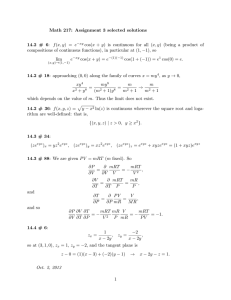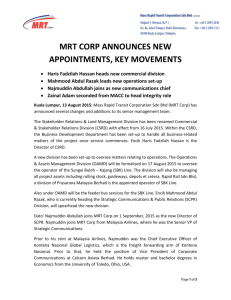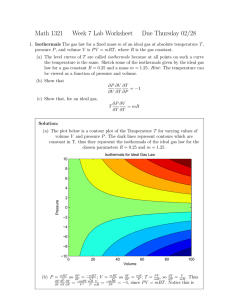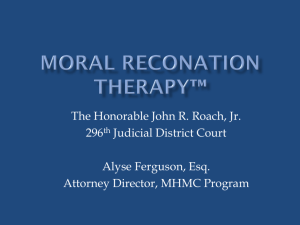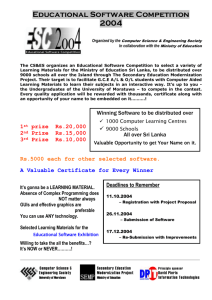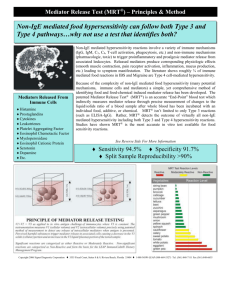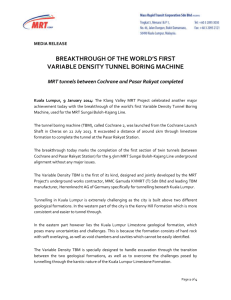M REPORT BRIEF IN
advertisement
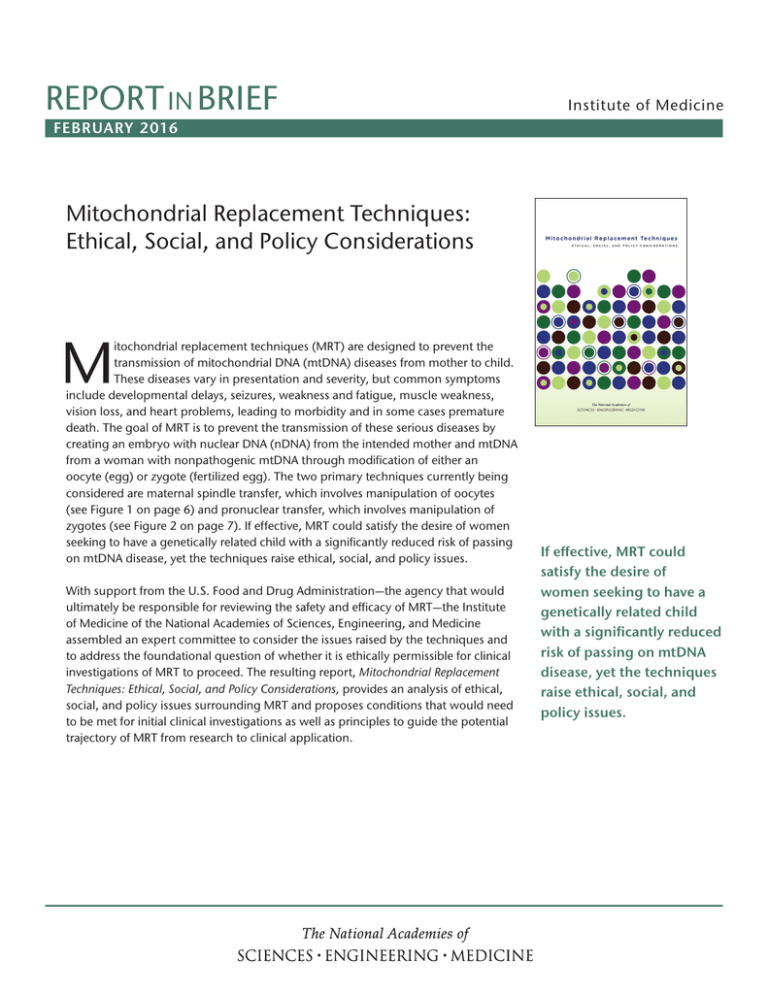
REPORT IN BRIEF Institute of Medicine FEBRUARY 2016 Mitochondrial Replacement Techniques: Ethical, Social, and Policy Considerations M itoc hondria l R e pla ce me nt Te c h n i q u e s ETHICAL, SOCIAL, AND POLICY CONSIDERATIONS M itochondrial replacement techniques (MRT) are designed to prevent the transmission of mitochondrial DNA (mtDNA) diseases from mother to child. These diseases vary in presentation and severity, but common symptoms include developmental delays, seizures, weakness and fatigue, muscle weakness, vision loss, and heart problems, leading to morbidity and in some cases premature death. The goal of MRT is to prevent the transmission of these serious diseases by creating an embryo with nuclear DNA (nDNA) from the intended mother and mtDNA from a woman with nonpathogenic mtDNA through modification of either an oocyte (egg) or zygote (fertilized egg). The two primary techniques currently being considered are maternal spindle transfer, which involves manipulation of oocytes (see Figure 1 on page 6) and pronuclear transfer, which involves manipulation of zygotes (see Figure 2 on page 7). If effective, MRT could satisfy the desire of women seeking to have a genetically related child with a significantly reduced risk of passing on mtDNA disease, yet the techniques raise ethical, social, and policy issues. With support from the U.S. Food and Drug Administration—the agency that would ultimately be responsible for reviewing the safety and efficacy of MRT—the Institute of Medicine of the National Academies of Sciences, Engineering, and Medicine assembled an expert committee to consider the issues raised by the techniques and to address the foundational question of whether it is ethically permissible for clinical investigations of MRT to proceed. The resulting report, Mitochondrial Replacement Techniques: Ethical, Social, and Policy Considerations, provides an analysis of ethical, social, and policy issues surrounding MRT and proposes conditions that would need to be met for initial clinical investigations as well as principles to guide the potential trajectory of MRT from research to clinical application. If effective, MRT could satisfy the desire of women seeking to have a genetically related child with a significantly reduced risk of passing on mtDNA disease, yet the techniques raise ethical, social, and policy issues. Concerns raised by potential heritable genetic modification warrant exercising significant caution and imposing restrictions rather than completely prohibiting the use of MRT to prevent transmission of serious mtDNA disease. ETHICAL ANALYSIS In its ethical analysis of MRT, the committee’s key findings and conclusions include: female offspring would constitute heritable genetic modification, also known as germline modification, as these children could pass on these genetic changes. Such modification is not heritable in males, however, since sperm do not contribute mtDNA to the next generation. Thus, MRT producing male offspring would not constitute heritable genetic modification (germline modification). Demand for MRT Prospective parents’ seeking to use MRT to satisfy their desire to have children who are at significantly reduced risk of manifesting serious mtDNA disease and with whom they have a genetic connection is justifiable within the limits of protecting the health and well-being of the children who would be born as a result. Concerns raised by potential heritable genetic modification warrant exercising significant caution and imposing restrictions rather than completely prohibiting the use of MRT to prevent transmission of serious mtDNA disease. Heritable genetic modification MRT results in genetic modification of germ cells. Because mtDNA is solely inherited from the mother, MRT producing DISTINCTIONS BETWEEN MODIFICATION OF mtDNA AND nDNA There are significant and important distinctions between modification of mtDNA and nDNA. • MRT is different from any technology that could be applied to the nuclear genome in that it would entail replacement of pathogenic mtDNA with unaffected mtDNA, as opposed to targeted genomic editing of either mtDNA or nDNA. The replacement of whole, intact, and naturally occurring mitochondrial genomes represents a qualitatively different form of potentially heritable genetic change from that resulting from any approach for modifying nDNA, which would likely involve gene editing rather than wholesale replacement. • Although mtDNA plays a central role in genetic ancestry, traits that are carried in nDNA are those that in the public understanding constitute the core of genetic relatedness in terms of physical and behavioral characteristics, as well as most forms of disease. • Though some forms of energetic “enhancement” (such as selecting for mtDNA to increase aerobic capacity or cognitive skills) might hypothetically be possible through MRT, they appear to be far less likely relative to what might be possible in modifications of nDNA. The significant and important distinctions between modification of mtDNA to prevent transmission of mtDNA disease through MRT and modification of nDNA have implications for the ethical, social, and policy issues associated with MRT. These distinctions could allow justification of MRT independent of decisions about heritable genetic modification of nDNA. 2 The committee concludes that it is ethically permissible to conduct clinical investigations of MRT subject to certain conditions and principles. Unintended downstream social implications Federal regulation would be needed—and principled professional society guidelines that interpret the regulations would be helpful—to limit the use of MRT to preventing transmission of serious, life-threatening mtDNA diseases, as well as to prevent slippage into applications that raise other serious and unresolved ethical issues. Identity, kinship, and ancestry An individual born as a result of MRT would have genetic contributions from two women of different maternal lineage. This would introduce complexities that might affect how the individual experiences his or her identity, kinship, and ancestry, as well as possibly affecting future descendants of any females born as a result of MRT. These complexities do not form a basis for prohibiting initial investigation of MRT; rather, they are a matter for reflection by families considering undertaking MRT and for societal discussions related to conceptions of identity, kinship, and ancestry. Manipulation of human embryos Religious, ethical, social, and policy issues are associated with the creation, manipulation, and destruction of human embryos. However, the responsible use of human embryos in research on and clinical use of MRT would give women at risk of transmitting mtDNA diseases the opportunity to have genetically related children who would be at significantly reduced risk of having these diseases. Useful ethical frameworks that have already been developed could inform appropriate parameters for embryo manipulation in the conduct of preclinical and clinical investigations of MRT. While significant ethical, social, and policy considerations are associated with MRT, the most germane of these issues can be avoided through limitations on the use of MRT or are blunted by meaningful differences between the heritable genetic modification introduced by MRT and heritable genetic modification of nDNA. Therefore, the committee concludes that it is ethically permissible to conduct clinical investigations of MRT subject to certain conditions and principles. CONDITIONS AND PRINCIPLES TO GUIDE MRT INVESTIGATIONS AND OVERSIGHT Having addressed the foundational question of whether it is ethically permissible for clinical investigations of MRT to proceed, the committee considered the conditions and principles necessary to guide clinical investigations and oversight of MRT (see the report’s recommendations for a full explanation of these conditions and principles). Conditions for ethical MRT first-in-human clinical investigations Initial MRT clinical investigations should be considered by FDA only if and when the following conditions can be met: • Initial safety is established, and risks to all parties directly involved in the proposed clinical investigations are minimized. • Likelihood of efficacy is established by preclinical research using in vitro modeling, animal testing, and testing on human embryos as necessary. 3 In the committee’s judgment, a slow, cautious approach to MRT is justified, with the requirement of deliberate and continued attention to ethical, social, and policy issues. • Clinical investigations are limited to women who otherwise are at risk of transmitting a serious mtDNA disease, where the mutation’s pathogenicity is undisputed and the clinical presentation of the disease is predicted to be severe, as characterized by early mortality or substantial impairment of basic function. Principles for a cautious approach If the conditions for ethical MRT first-in-human clinical investigations are met, FDA should ensure that the design and conduct of initial and subsequent clinical investigations of MRT adhere to the following principles and practices: • The health and well-being of any future children born as a result of MRT protocols should have priority in the balancing of benefits and risks in clinical investigations. • If the intended mother at risk of transmitting mtDNA disease is also the woman who will carry the pregnancy, professional opinion informed by the available evidence determines that she would be able to complete a pregnancy without significant risk of serious adverse consequences to her health or the health of the fetus. • Study designs of MRT protocols should be standardized to the extent possible to enable valid comparisons and pooling of outcomes across groups. • Intrauterine transfer for gestation is limited to male embryos in order to prevent potential adverse and uncertain consequences of MRT from being passed on to future generations. (Conditions for an ethical expansion of MRT research to include transfer of female embryos are outlined below.) • Data from research or clinical practices outside FDA jurisdiction should be incorporated into FDA’s analysis. • Clinical investigations should collect long-term information regarding psychological and social effects on children born as a result of MRT, including their perceptions about their identity, ancestry, and kinship. • Clinical investigations are limited to investigators and centers with demonstrated expertise in and skill with relevant techniques. • FDA has reviewed haplogroup/haplotype matching and if compelling, considered it as a means of mitigating the possible risk of mtDNA-nDNA incompatibilities. Conditions for an ethically permissible expansion of MRT research Following successful initial investigations of MRT in males, FDA could consider extending MRT research to include the transfer of female embryos if: In addition to attention to best practices for consent in research, FDA, research institutions, investigators, and institutional review boards should pay special attention to communicating the novel aspects of this research to MRT research participants. (See Recommendation 5 in the report for a full explanation of the committee’s conditions for informed consent). • clear evidence of safety and efficacy from male cohorts, using identical MRT procedures, were available, regardless of how long it took to collect this evidence; • preclinical research in animals had shown evidence of intergenerational safety and efficacy; and 4 The health and well-being of any future children born as a result of MRT protocols should have priority in the balancing of benefits and risks in clinical investigations. • Circumscribed use: FDA should use the means at its disposal to limit the use of MRT to the indications, individuals, and settings for which it is approved, and should engage the public in a fresh ethical analysis of any decision to broaden the use of MRT. • FDA’s decisions were consistent with the outcomes of public and scientific deliberations to establish a shared framework concerning the acceptability of and moral limits on heritable genetic modification. • Long-term follow-up: FDA should require that sponsors design, fund, and commit to long-term monitoring of children born as a result of MRT, with a plan for periodic review of the long-term follow-up data. Guiding principles for oversight FDA’s overall plan for review and possible approval and subsequent marketing of MRT should incorporate the following elements: •Transparency: Regulatory authorities should maximize timely public sharing of information concerning the MRT activities and decisions within their jurisdiction. FDA should encourage sponsors to commit to depositing protocols and deidentified results in public databases. • Public engagement: Regulatory authorities should incorporate ongoing exploration of the views of relevant stakeholders into the overall plan for review and possible marketing of MRT and should support opportunities for public meetings to gather these views. • Partnership: FDA should collaborate with other regulatory authorities within and outside the United States to improve the quality of the data available for the assessment of benefits and risks. CONCLUSION MRT introduces a novel collection of ethical, social, and policy issues and a new challenge for the U.S. regulatory system. The committee’s analysis included recognizing the importance of research for advancing medicine, in light of the ethical, social, and policy concerns raised by this technology, including respect for the interests of women who carry a risk of passing on serious disease, tempered by consideration of the risks and uncertainties of a first-in-human application of MRT. In the committee’s judgment, a slow, cautious approach to MRT is justified, with the requirement of deliberate and continued attention to ethical, social, and policy issues.♦♦♦ • Maximizing data quality: FDA should require that sponsors have adequate resources, use appropriate designs, and plan studies that enable crossreferencing and pooling of data for assessments of benefits and risks. 5 6 2. 1. MII oocyte PB1 Karyoplast containing intended mother ’s spindle-chromosome complex 3. Discarded KEY Wild-type mtDNA Reconstructed oocyte 4. Mutated, pathogenic mtDNA Pronuclearstage zygote 5. PB2 S O U R C E : R i c h a rd s o n , J . , L . I r v i n g , L . A . H y s l o p , M . C h o u d h a r y, A . M u rd o c h , D. M . Tu r n b u l l , a n d M . H e r b e r t . 2 0 1 5 . C o n c i s e rev i ew s : A s s i s t e d re p ro d u c t i ve t e c h n o l o g i e s t o p reve n t t ra n s m i s s i o n o f m i t o c h o n d r i a l D N A d i s e a s e . S t e m C e l l s 3 3 ( 3 ) : 6 3 9 - 6 4 5 . N OT E S : C e l l s a n d c e l l u l a r c o n t e n t s n o t d ra w n t o s c a l e ; M I I o o c y t e = m e t a p h a s e I I o o c y t e ; P B 1 a n d P B 2 = 1 s t a n d 2 n d p o l a r b o d y 1 . T h e s p i n d l e - c h ro m o s o m e c o m p l ex i s re m ove d a s a k a r yo p l a s t f ro m t h e p rov i d e r o o c y te a n d d i s c a rd e d . 2 . T h e s p i n d l e - c h ro m o s o m e c o m p l ex i s re m ove d a s a k a r yo p l a s t f ro m t h e i n t e n d e d m o t h e r ’s o o c y t e a n d f u s e d t o t h e p rov i d e r o o c y t e f ro m w h i c h t h e n u c l e a r D N A ( n D N A ) m a t e r i a l h a s b e e n re m ove d ; t h e i n t e n d e d m o t h e r ’s o o c y t e i s d i s c a rd e d . 3 . T h e re c o n s t r u c te d o o c y t e c o n t a i n s t h e i n t e n d e d m o t h e r ’s n D N A a n d p rov i d e r ’s n o n p a t h o g e n i c m t D N A . 4 . T h e re c o n s t r u c te d o o c y t e i s f e r t i l i z e d by i n t ra c y t o p l a s m i c s p e r m i n j e c t i o n ( I C S I ) w i t h t h e s p e r m p rov i d e r ’s s p e r m . 5 . T h e f e r t i l i z e d o o c y t e i s c u l t u re d i n v i t ro a n d t ra n s f e r re d a t t h e b l a s t o c y s t s t a g e t o t h e wo m a n w h o w i l l c a r r y t h e p re g n a n c y. Intended Mother Oocyte Provider F i g u r e 2 - 5 : M a t e r n a l S p i n d l e Tra n s f e r FIGURE 1 Maternal Spindle Transfer. FIGURE 1 Maternal spindle transfer (MST) would entail removal of nDNA from the intended mother’s oocyte and its subsequent fusion to an oocyte provided by another woman that contained nonpathogenic mtDNA and from which the nDNA had been removed. 7 Wild-type mtDNA MII oocyte PB2 Mutated, pathogenic mtDNA 4. Pronuclearstage zygote 3. Tra n s f e r Karyoplast containing intended parents’ pronuclei Discarded Reconstructed zygote 5. S O U R C E : R i c h a rd s o n , J . , L . I r v i n g , L . A . H y s l o p , M . C h o u d h a r y, A . M u rd o c h , D. M . Tu r n b u l l , a n d M . H e r b e r t . 2 0 1 5 . C o n c i s e rev i ew s : A s s i s t e d re p ro d u c t i ve t e c h n o l o g i e s t o p reve n t t ra n s m i s s i o n o f m i t o c h o n d r i a l D N A d i s e a s e . S t e m C e l l s 3 3 ( 3 ) : 6 3 9 - 6 4 5 . N OT E S : C e l l s a n d c e l l u l a r c o n t e n t s n o t d ra w n t o s c a l e ; M I I o o c y t e = m e t a p h a s e I I o o c y t e ; P B 1 a n d P B 2 = 1 s t a n d 2 n d p o l a r b o d y 1 . T h e p rov i d e r o o c y t e i s f e r t i l i z e d by i n t ra c y t o p l a s m i c s p e r m i n j e c t i o n ( I C S I ) w i t h t h e s p e r m p rov i d e r ’s s p e r m . 2 . T h e i n t e n d e d m o t h e r ’s o o c y t e i s f e r t i l i z e d by I C S I w i t h t h e s p e r m p rov i d e r ’s s p e r m . 3 . T h e m a l e a n d f e m a l e p r o n u c l e i a re re m ove d f ro m t h e p rov i d e r z yg o t e a n d d i s c a rd e d . 4 . T h e m a l e a n d f e m a l e p r o n u c l e i a re re m ove d f ro m t h e i n t e n d e d m o t h e r ’s z yg o t e a n d f u s e d t o t h e e n u c l e a t e d p rov i d e r z yg o t e . T h e e n u c l e a t e d z yg o t e o f t h e i n t e n d e d m o t h e r i s d i s c a rd e d . 5 . T h e re c o n s t r u c te d z yg o t e c o n t a i n s m a l e a n d f e m a l e n D N A f r o m t h e i n t e n d e d m o t h e r a n d s p e r m p rov i d e r a n d n o n p a t h o g e n i c m t D N A f ro m t h e o o c y t e p rov i d e r. T h e z yg o t e i s c u l t u re d i n v i t ro a n d t ra n s f e r re d a t t h e b l a s t o c y s t s t a g e t o t h e wo m a n w h o wo u l d c a r r y t h e p re g n a n c y. KEY 2. 1. PB1 FIGURE 2r ePronuclear Figu 2 - 6 : P r o nTransfer. uclear Oocyte Provider Intended Mother FIGURE 2 Pronuclear transfer (PNT) would entail the transfer of nDNA between fertilized oocytes, or zygotes, prior to fusion of the pronuclei (syngamy). The reconstructed zygote would contain nDNA from the intended parents and mtDNA from a provider. Committee on the Ethical and Social Policy Considerations of Novel Techniques for Prevention of Maternal Transmission of Mitochondrial DNA Diseases Jeffrey Kahn (Chair) Johns Hopkins Berman Institute of Bioethics Jeffrey Botkin University of Utah David Chan California Institute of Technology R. Alta Charo University of Wisconsin– Madison James Childress University of Virginia Alan DeCherney National Institutes of Health Marni Falk The Children’s Hospital of Philadelphia and University of Pennsylvania Perelman School of Medicine Jonathan Kimmelman McGill University Anna Mastroianni University of Washington Vamsi Mootha Harvard Medical School and Howard Hughes Medical Institute Laurie Strongin Hope For Henry Foundation Keith Wailoo Princeton University Study Staff Anne B. Claiborne Study Director Rebecca A. English Program Officer Andrew M. Pope Director, Board on Health Sciences Policy Morgan L. Stathem Associate Program Officer Michael J. Berrios Senior Program Assistant Ellen Kimmel Senior Research Librarian Study Sponsor U.S. Food and Drug Administration iom.nationalacademies.org Copyright 2016 by the National Academy of Sciences. All rights reserved. 8
